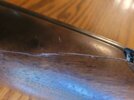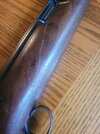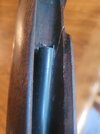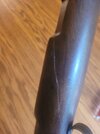Before getting a new stock, I would try sanding down the raised area at the crack, stripping off the old finish and refinishing it with multiple coats of tung oil. If the glue got down into the wood fibers, it should hold well. If there is any open crack on the inside or outside, put some wood glue in a syringe and inject it into the crack and allow it to dry and then sand flush. I believe you will be surprised how well it will turn out. I have repaired and refinished several old walnut stocks with good results.
Is your rifle for long rifle or shorts? I have one in short and LR. I don't recall if there are any differences in the stock or not, but I believe there might be some differences between the early rifles and later ones. Should be able to look up the serial number to get an estimate when it was made. A new stock will probably need inletting and finishing, compared to an original stock.
I took the 74 short that I got from my grandfather, and gave it a good cleaning, including removing the magazine tube out of the stock and it was filthy with crud and rust. I don't think it had ever been cleaned other than maybe a brush down the barrel.
View attachment 776671












